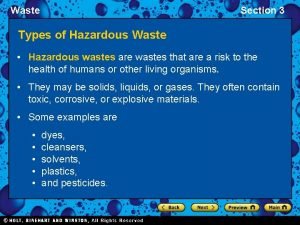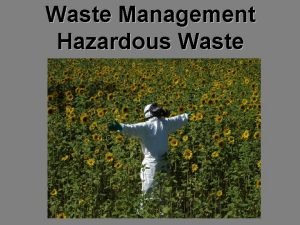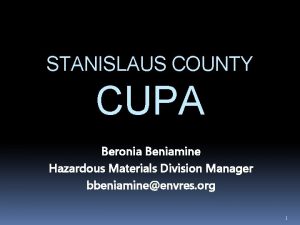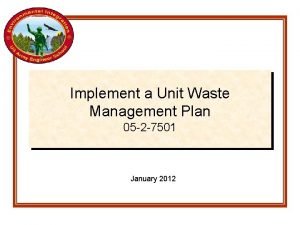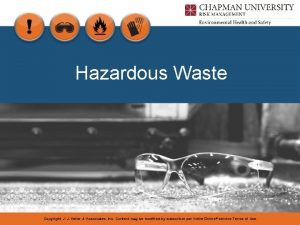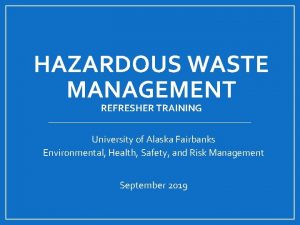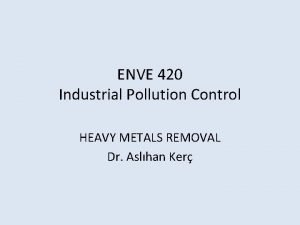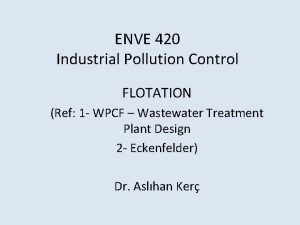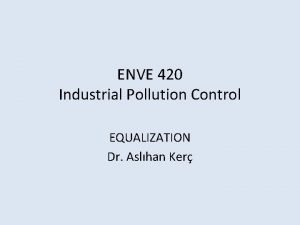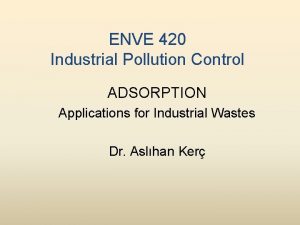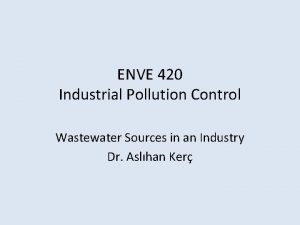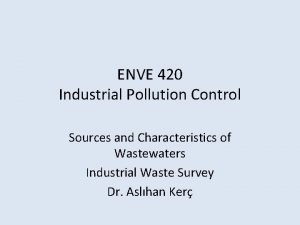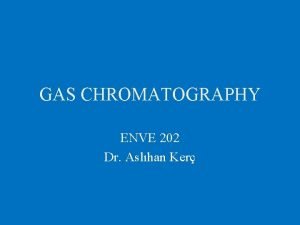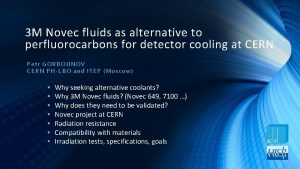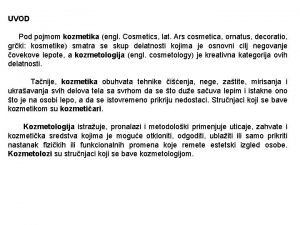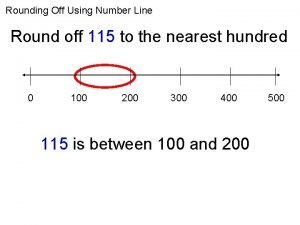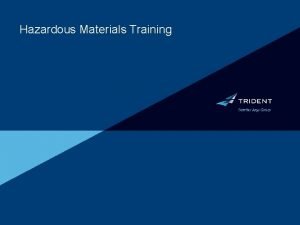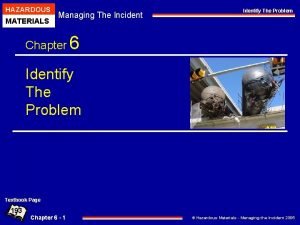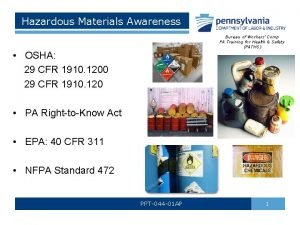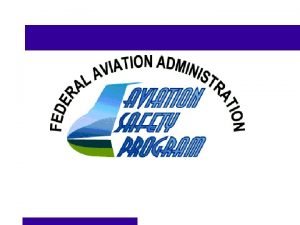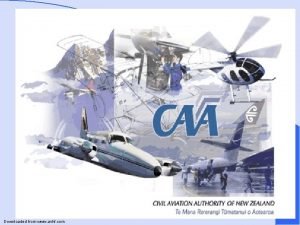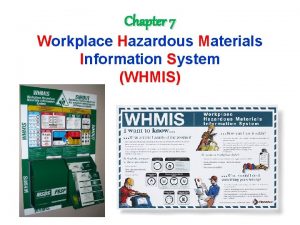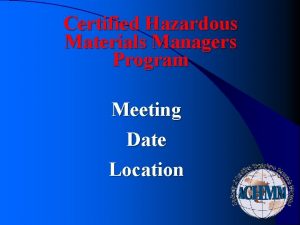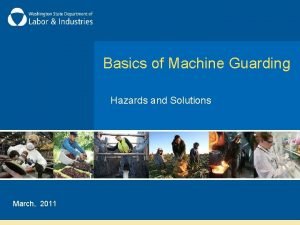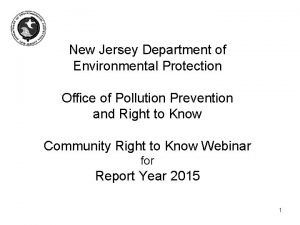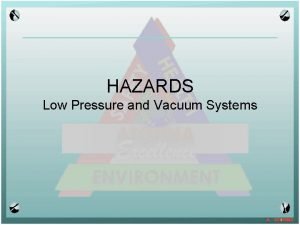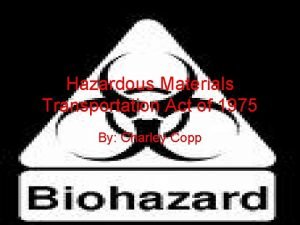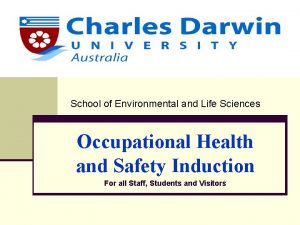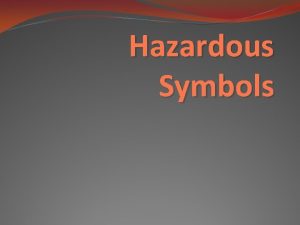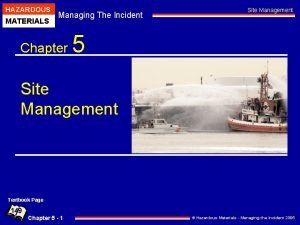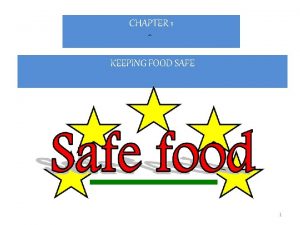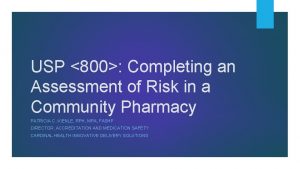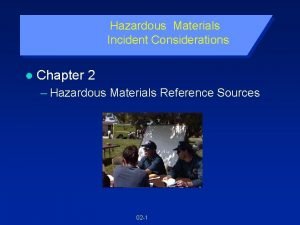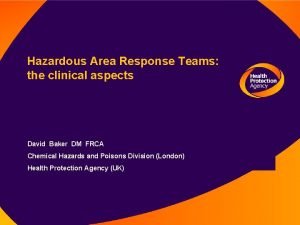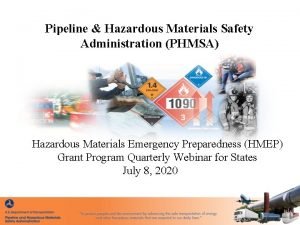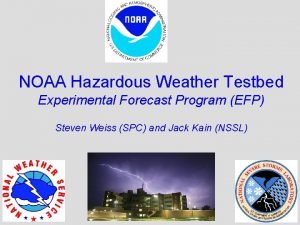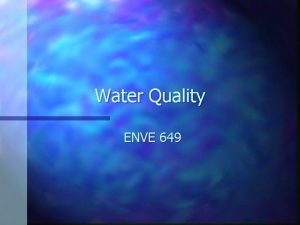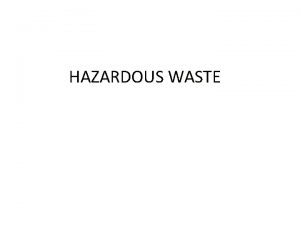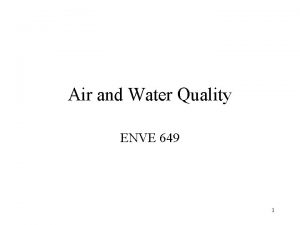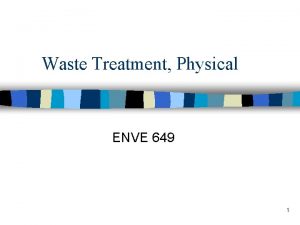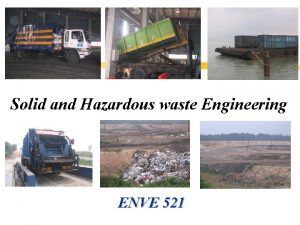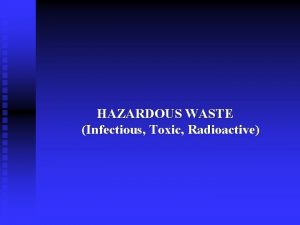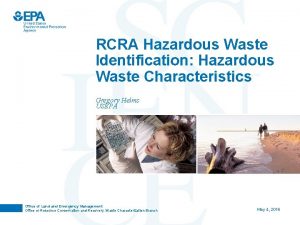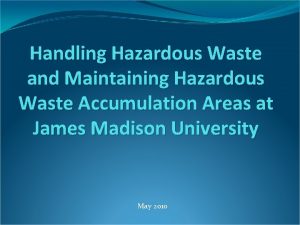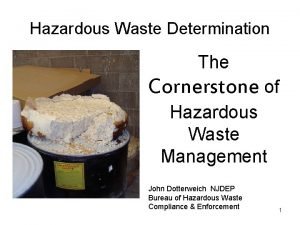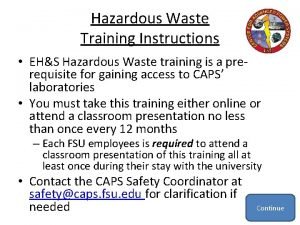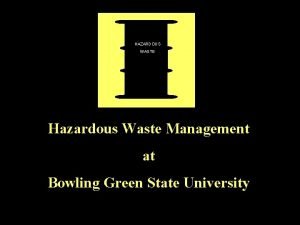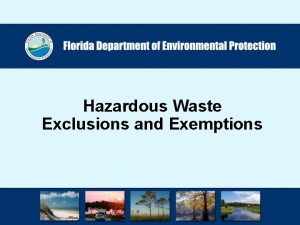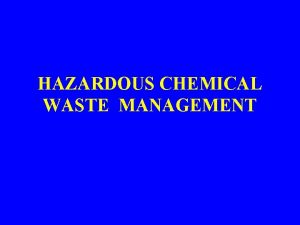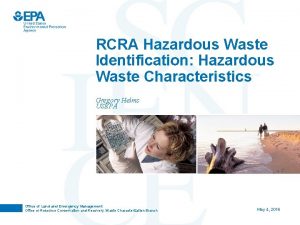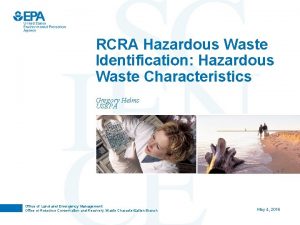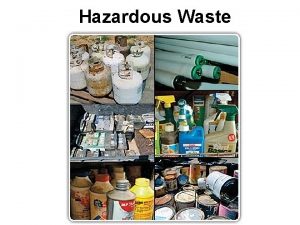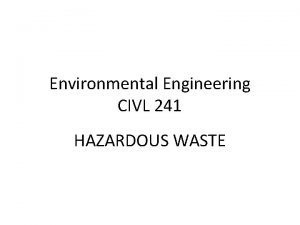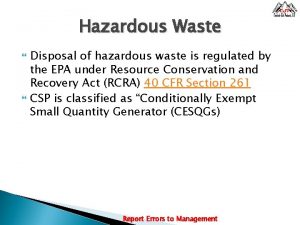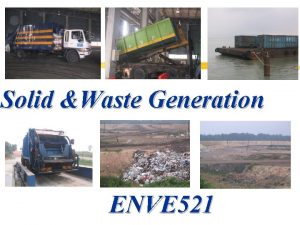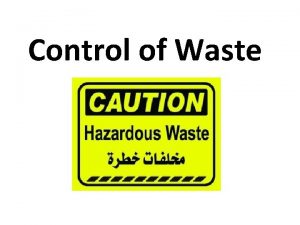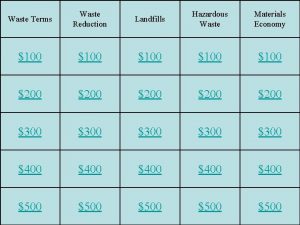Water Quality ENVE 649 Water Quality Hazardous waste














































- Slides: 46

Water Quality ENVE 649

Water Quality Hazardous waste winds up in water n If it can be legally discharged to water it may not be hazardous n

Classes of receiving waters Fresh surface waters n Ground water n Salt water n

Main Laws n Fresh surface waters – Clean Water Act (1972) – Clean Water Act Amendments (1987) n Ground water – Safe Drinking Water Act (1974) n Salt water – Several

Clean Water Act History n “…restore and maintain the chemical physical and biological integrity of the nations’ waters. ” n “Discharge (from a point source) of pollutants into the navigable waters be eliminated and that, where attainable, the water quality …support fishing and swimming. ” n

What is a “pollutant” Very broad statutory definition n No regulatory or de minimis exception n Every discharge is covered, provided other requirements are present. n

All point sources will be required to obtain a National Pollution Discharge Elimination System (NPDES) permit.

What is a “point source”? Pipes, for sure n Also surface water, if it is channeled or collected n Non-point, which are excluded from NPDES are such as: runoff from streets and farms, timber operations, construction sites. (Less restrictive regulatory schemes for these. ) n

What are “navigable waters” Pretty much all surface waters that might be used in interstate commerce, or n might affect interstate commerce, such as lake and wetlands n Typically near shore salt waters are included, oceans are not. n

The next slides discuss the level of treatment that the NPDES will require. As you go look at the slides, you will realize that the levels of treatment are not “cast in concrete, ” but will vary with time and the particular industries and processes involved.

Restrictions on Pollutants Often expressed as weight of pollutant per weight of product n Different for different industries n Standards applied through individual plants through NPDES permit. n Terminology n

Industrial Dischargers n Existing (old) Direct – BPT, Best practical technology, n considers cost – BAT, Best available technology that is economically achievable. n For toxic pollutants – BCT, Best conventional technology for “conventional pollutants”-BOD, SS, p. H n start with BPT and consider improvements n

Industrial Dischargers n Industrial, new, Direct – BADT, Best available demonstrated technology little consideration of cost n no variances based on specific circumstances. n

So the standards are more stringent for new potential polluters than for existing polluters.

Indirect Dischargers n Indirect = through POTW – Publicly owned treatment works n n n Pretreaters No NPDES permit, but “pretreatment standards” Must not “pass through” or interfere – With POTW operations. n Pretreater (the industry that is discharging) is regulated (in the first instance) by POTW, rather than agency.

The POTW themselves must get an NPDES permit.

POTW The permits will require: n Achieve “secondary treatment” n Numerical values for BOD, SS, p. H n

NPDES Program National Pollution Discharge Elimination System n When writing the permit, the agency will consider two main criteria: 1. Technology based standards on all industries (BADT) 2. Further controls such that receiving waters maintains compliance with water quality standards n

Standards for receiving waters n Anti-degradation Policy – existing uses shall be maintained – If existing will support propagation of fish, shellfish, wildlife and recreation, it must be maintained at that level, unless – State proves some economic necessity Narrative Criteria n Numerical Standards n Relate to “use” n

Various “Uses” Set by States, EPA reviews n Public water supply n Protection of fish, shellfish, and wildlife n Recreation n Agriculture n Industry n Navigation n

Narrative Standards n Waters shall be free from discharges that: – Settle to form objectionable deposits – Float as debris, scum, oil, nuisances – Produce objectionable color, taste, odor, turbidity – Cause injury or adverse physiological responses in humans or animals – Produce undesirable aquatic life.

Numeric Criteria n Pollutants – metals, organics, etc. – EPA list of pollutants subject BADT – AKA “priority pollutants. ” n In-stream criteria – p. H, DO, chlorides, sulfates n Based on human health and wildlife, for the intended use

What if the receiving waters are already more polluted than allowed for the intended use of the water?

TMDL’s n n Permit issuer (EPA or a few states) Determines that technology based standards will not achieve water quality standards – pollutant specific n Issuer develops “total maximum daily loads” (TMDL) of pollutant that water body can assimilate and comply with WQ standards.

TMDL refers to each toxic substance. n Allocate TMDL to various point and nonpoint sources n Might reserve for future development, or n Account for scientific uncertainty n

That is, all the NPDES permitees that discharge into the water can be limited. (They would have to limit their production or operations, or invest in better pollution protection equipment. )

Detail on Pretreatment Administered by POTW n Subject to detailed regulations and oversight by EPA, NPDES regulators n Purpose to avoid: n “Pass-through” and n “Interference” n

Pretreatment n n Monitor significant industrial users Important general limitations – – n hot material corrosive explosive health and safety of POTW workers Special limitations for certain industries – ‘categorical limitations” n Local limits

When writing the NPDES permit, the agency might specify that the contaminants be measured in the receiving waters, beyond some mixing zone.

Mixing Zone n Compliance boundary – zone of dilution before compliance with relevant WQ standard is measured 100 Meters is common n Unless inappropriate n – exposures in MZ

Stormwater Foregoing was “point source” n Stormwater is also often point source n – under-regulated by EPA until – 1987 amendments to CWA – now firmly regulated – subject to varying deadlines n Industrial vs. Municipal

Industrial Stormwater Broadly, stormwater n Related to Industrial use n Raw materials storage n lists 11 major categories n Including: 1. construction of more than 1 acre (had been 5) 2. landfills 3. recycling facilities n

Industrial Applications n n Individual or Group application Must meet CWA criteria (called section 301) – technology – water quality based n General Permits – A general permit might be issued for an area, requiring less stringent administration.

Municipal Permits Similar to Industrial n Municipalities must prevent nonstormwater discharges in storm sewers n Reduce pollutants to maximum extent practical n

Wetlands Section 404 of CWA n not usually HW issue n

SDWA and Groundwater All foregoing was CWA, discharges to fresh surface water. n SDWA, Safe Drinking Water Act n Deals primarily with tap water, what people drink. n Not Hazardous Waste topic, usually n

HW issues in SDWA Underground injection well, control n Also n Drinking Water MCLGs and MCLs n – maximum contaminant level goals – maximum contaminant levels

Wells that inject hazardous waste are permitted.

Classes of Injection Wells n n n I. Hazardous Waste injection below underground source of drinking water (with 1/4 mile) II. Industrial, oil and gas mostly, III. Certain mineral extraction IV. (old) HW with 1/4 mile of water source V. (old) Typically cesspools and drywells. See: http: //www. epa. gov/safewater/uic/classv. htm l

Therefore n Any discharge to groundwater that is not a permitted injection well is illegal

Class IV and V wells are being phased out. Class II are mostly oil and gas industry putting drill cuttings and mud back into the hole. Class III are sulfur and salt extraction wells and similar processes.

Class I wells have many restrictions and many types of HW cannot be sent to a Class I well.

MCLG and MCLs n n These are numerical standards for drinking water that central water works pipe to residences. The recent flap about the arsenic standard was about an MCLs are valuable because they provide a number that one can argue is safe. So if a HW discharge to a pond will not drive the pond water over the relevant MCL, the polluter may argue that the pond water is “safe enough to drink. ”

Discharges to marine (salt) waters come under different laws than fresh waters.

Marine Waters n The “Ocean Dumping Act, ” also known as Marine Protection, Research and Sanctuaries Act. – No radiological, chemical, and biological warfare agents or high-level radioactive wastes may be dumped. – Sewage sludge and industrial wastes were prohibited by an earlier act.

Ocean Dumping of other substances may be permitted by EPA n Corps of Engineers may dump dredge spoil, but must notify EPA n – The muck that is dredged from rivers and harbors is often contaminated such that the dredged material is a hazardous waste.
 Section 3 hazardous waste answers
Section 3 hazardous waste answers Color coding for waste disposal
Color coding for waste disposal E-waste definition apes
E-waste definition apes What is toxic waste
What is toxic waste Stanislaus county hazardous materials division
Stanislaus county hazardous materials division Waste management references
Waste management references Solid and hazardous waste
Solid and hazardous waste Hazardous waste transportation
Hazardous waste transportation Hazmat training alaska
Hazmat training alaska Enve420
Enve420 Enve420
Enve420 Enve 420
Enve 420 Enve 420
Enve 420 Enve420
Enve420 Enve420
Enve420 Google.com
Google.com Water and water and water water
Water and water and water water 860 en yakın yüzlüğe yuvarlama
860 en yakın yüzlüğe yuvarlama 550 sayısı hangi yüzlüğe yuvarlanır
550 sayısı hangi yüzlüğe yuvarlanır Novec 649/1230
Novec 649/1230 Softisan 649 inci
Softisan 649 inci 649+330
649+330 What is 115 rounded to the nearest hundred
What is 115 rounded to the nearest hundred Aviation hazardous attitudes
Aviation hazardous attitudes Dot
Dot Hazardous materials table
Hazardous materials table Us military marking system for hazardous materials
Us military marking system for hazardous materials Pa-psfa-hazardous materials awareness
Pa-psfa-hazardous materials awareness Avhf
Avhf 5 hazardous attitudes
5 hazardous attitudes Workplace hazardous materials information system symbols
Workplace hazardous materials information system symbols Certified hazardous materials manager
Certified hazardous materials manager What's the guarding hazard in the image?
What's the guarding hazard in the image? Nj crtk environmental hazardous substances
Nj crtk environmental hazardous substances Igcse
Igcse Hazardous materials transportation act of 1975
Hazardous materials transportation act of 1975 Hazardous area training darwin
Hazardous area training darwin Hazardous symbols
Hazardous symbols Hazardous materials managing the incident
Hazardous materials managing the incident Keeping food safe chapter 1
Keeping food safe chapter 1 Hazardous drug api
Hazardous drug api On july 18 2001 a train carrying hazardous chemicals
On july 18 2001 a train carrying hazardous chemicals Hazardous materials reference books
Hazardous materials reference books Hazardous area response team
Hazardous area response team Hazardous movement asl
Hazardous movement asl Pipeline and hazardous materials administration
Pipeline and hazardous materials administration Hazardous weather testbed
Hazardous weather testbed
